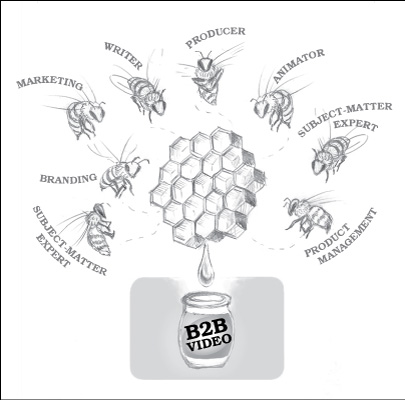I was asked in a LinkedIn group discussion, “If you don’t use storyboards, how do you develop the finished product, particularly if a team is working on it?”
A creative process and a business process
B2B video is as much a business process as it is a creative process. Like many business processes today, there’s an ad hoc team on the case. Good teamwork comes about when everyone on the team is doing work they are good at. So I prefer a process that is as close as possible to WYSIWG, where everyone can respond based on what they know, not what they can envision (based on, say, storyboards).

Who is on the team?
Teams we work with generally consist of one or two marketing execs, a product manager, and several subject matter experts (SMEs). So, six or seven folks have input into the initial script, and members of the same group will contribute ideas as the script is revised.
Now, that might sound like designing by committee, and to some extent, it is. The creative team would certainly prefer to minimize the number of “advisors”. But, if the content of the video is a business proposition, then it makes sense for the creative team to take advantage of all business knowledge available in the creative process.
The writer’s job
It’s the scriptwriter’s job to go with the flow during these iterations and re-shape the story to fit the essential information that needs to be put across. If you’re writing to a word count (~125 words/minute works for us), then the scriptwriter’s job is to come up with the best combination of words and pictures that will put across the value proposition to the target audience. A script writer told that features X, Y, and Z need to be added to the script, may put X into the visuals but not the narration, incorporate Y by taking a few words out of the narration elsewhere, and maybe try to convince the client that there just isn’t time to give feature Z its due. The scriptwriter will need to evaluate and negotiate these kinds of tradeoffs several times in order to keep the video short and lively.
The SME’s job
It’s the subject matter expert’s job to make sure the finished video talks to the target audience in a way he or she might talk to them. Many SMEs and marketing execs have a hard time imagining actual video on the basis of a script or storyboards.
Building B2B video teams
Storyboards don’t help much with team building. What’s worse, storyboards are not likely to be shared with people outside the group — like the members’ bosses who will have the final say on content and style.
In our company, we share “finished” animation throughout the production process. The voice track is temporary, so it can be easily changed as the team works together to shape the finished animations scene by scene. In this way, the video can be widely shared as it is developed. The iterative process also helps the team to coalesce.
For example, we recently worked on a video to introduce an IT solution aimed at local government. Everyone knew that it needed to show realistic examples of business processes that would be improved. But how many, and which ones, and how should they be shown? Animated workflow diagrams would more visual appeal; we could list more processes with kinetic text.
So we put placeholder text and diagrams into the video. Marketers, product management, SMEs and their bosses all joined in as they sought to agree on the list of six actual processes that would fit the available screen time, resonate with their audience, and represent the breadth of their solution’s application.
This kind of back-and-forth negotiation among team members is how a lot of business gets done these days. It works with creating B2B videos, too.
Once you put your team together and create your B2B content marketing videos – the question now becomes: How should you be using these content marketing videos throughout your complete sales, marketing and lead generation process?



